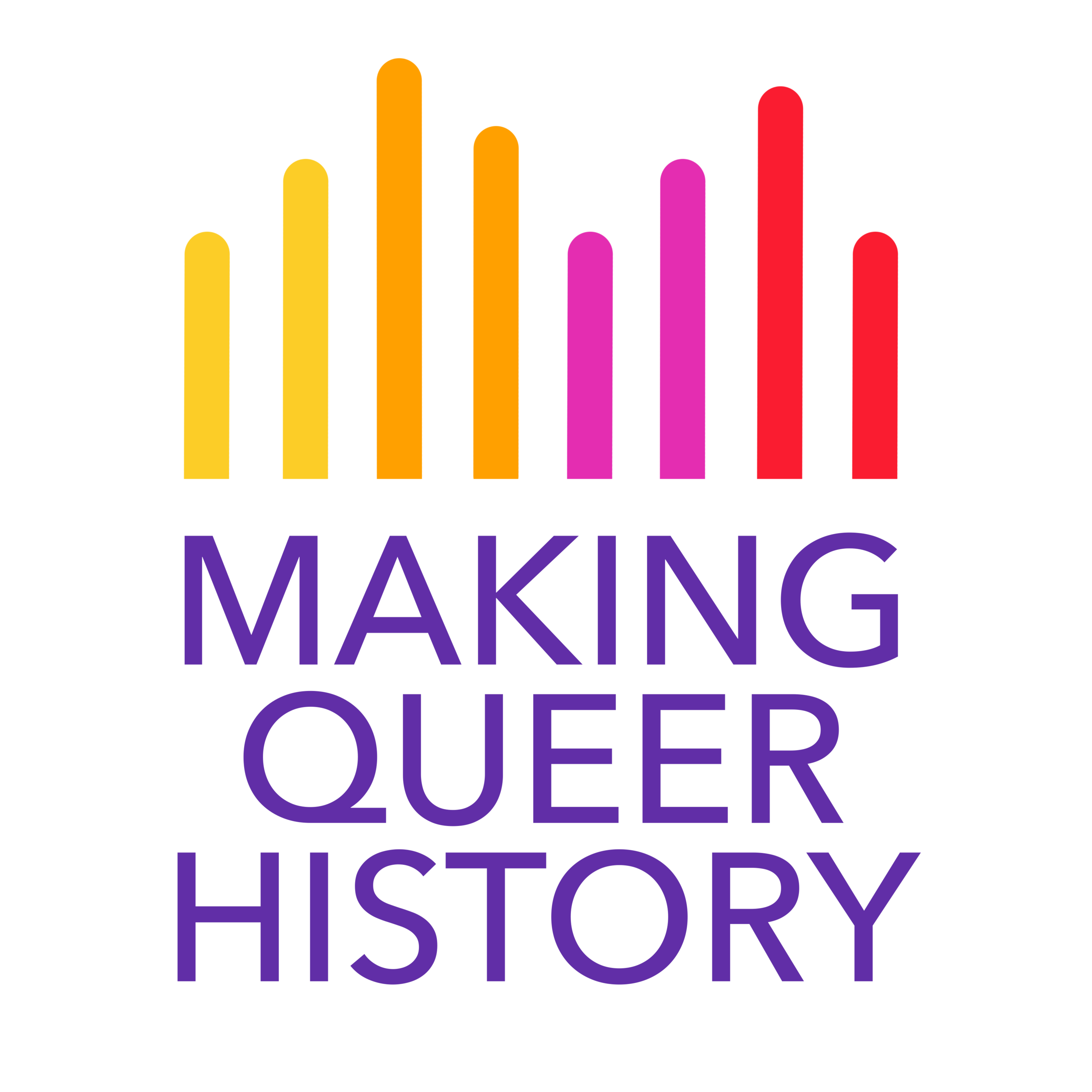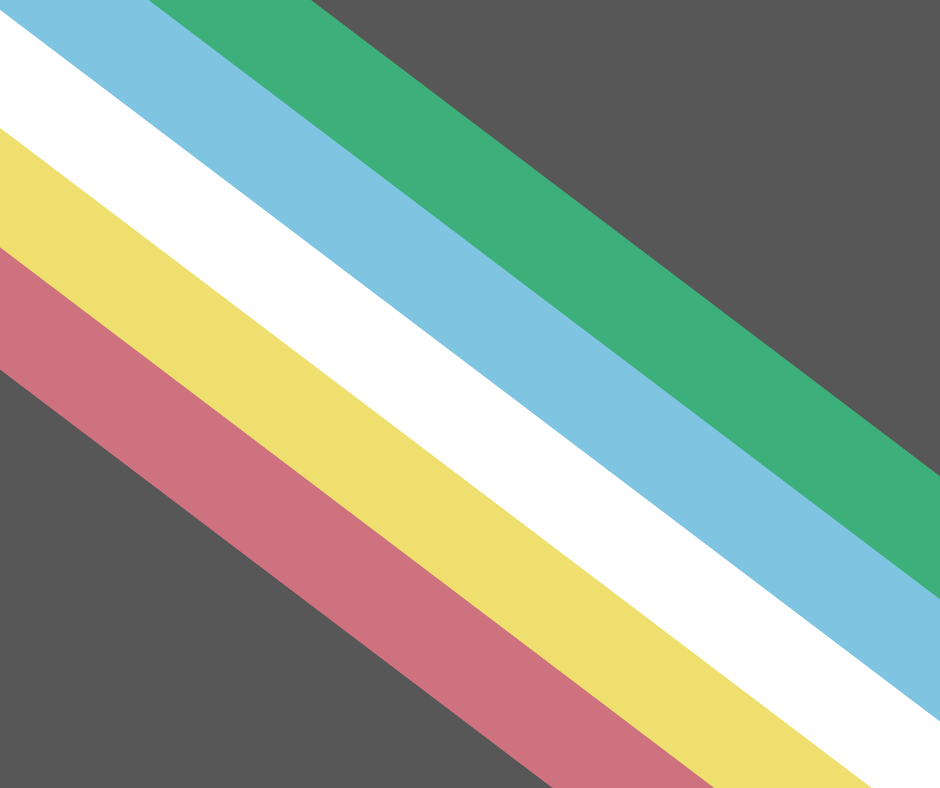The disability pride flag: 5 muted stripes of red, yellow, white, blue, and green against a gray background.
"'Cripple,' when I use it, allows me to take ownership of everyone’s misconceptions of disability. I know you’re scared of me; I know you think I’m different from you, and guess what? I am." — Andrew Gurza
There is something powerful in reclaiming language. There’s the shock value of it, but it’s also a way to take back some of the power. It’s a way to navigate a difficult experience; it’s not right for every person, but for many, it’s empowering. For queer crips, it’s a way to connect, to reject, and to describe the experience of feeling trapped between two communities.
Like queer, crip(ple) is a slur that has been reclaimed by many physically disabled people, especially those who also identify as queer. There are a lot of reasons that people identify as crip(ple)s, but like queer, one reason is to have a word that is yours. Some identify as crips to escape more pathologized language, or as a way to express an identity that goes beyond a diagnosis. It also subverts the idea that disabled people should hide their disabilities to comfort non-disabled people; it’s a way to preemptively address ableist assumptions head-on. It is based in the radical idea that disabled people can be openly disabled and still be deserving of respect.
Living as a disabled person is inherently political. But for a lot physically disabled folks who identify as queer crips, it’s also a day-to-day. It’s an identity with history and pride, yes, but it’s also a lived experience. Tai, the person who founded the Cripple Punk, said, “To be disabled and not hate yourself for it is a profound act of resistance.” That is, in part, why so many people identify as crips.
There’s this familiar idea that to be queer and to be disabled, especially physically disabled, must be two separate experiences. Not only is this plain wrong, it’s also concerning because of the long and overlapping history between the queer and the disabled communities. The need for equal access to housing, employment, and education continues. The fight to be free from discrimination and violence continues. The queer rights movement and the disability rights movement continue for these reasons and others. In the UK, for example, one in five queer people and nearly two in five disabled people have reported a hate crime in the last year.
Being a queer crip means navigating two worlds that don’t regularly see eye to eye. Queer spaces aren’t accessible a vast majority of the time. Disabled people are not only othered in these spaces by ableist opinions and language, because ableism crafts the space itself, but the spaces often are accessible enough to even enter. Disability-centric spaces tend to be just as cisheteronormative as most non-queer spaces, meaning queer people are othered both in and out of the space.
The way those experiences play on each other gives queer crips a unique perspective, but also makes them a target for further queerphobia, transphobia, and ableism. Like a lot of queer folks, disabled folks have often struggled to “pass” as abled, be it for safety, job security, or to access spaces, even if they’re only partially safe. Disabled queers are expected to perform because there is an idea of normalcy that we’re all forced into. Disabled bodies and trans bodies, especially, are seen as abnormal and “other”. If you do not perform, you are seen as not trying hard enough to be whatever it is you “want” to be, nevermind the issues behind “identifying as” versus “being”.
This is for everyone, but especially so for queer crips who are visibly disabled. We talk a lot about visibility in the queer community, and usually in a positive light. There are benefits to being more noticed, especially when that leads to education and understanding. But visibility also puts marginalized people at risk. Disabled people are already vulnerable and considered helpless. In that same vein, disabled folks are often desexualized, whereas queer folks are generally hypersexualized. So being visibly queer and disabled can be incredibly liberating, but it can also be incredibly dangerous. This is why identifying as a queer crip is a radical choice.
Whereas violence comes from those in power, queer crips also have to deal with criticism from other physically disabled people and other queer people. There are, of course, queerphobic disabled people. They believe being an openly queer disabled person “perverts” disability activism. But there are also those who believe reclaiming “crip” opens the entire community up to further ableism. And because internalized ableism exists, some disabled people think that identifying with their disabilities means giving up. Abled queer people feel that disability gets in the way of the queer movement, either taking up space or resources or both. Disability is never relevant unless it’s being used for inspiration porn. Inspiration porn is a term coined by the late disability rights activist Stella Young, referring to calling disabled people inspirational solely for being disabled. Aside from this, they maintain the belief that your queer identity should be the focus, never considering how intertwined queerness and disability are for so many.
And that is the fundamental thing about queer crips. It is not that two slurs, two words reclaimed from hate have been thrown together just because they can be. It is an identity of its own, and it is one of self-determination and representation. It does not apologize for the discomfort created by being a queer disabled person in our society; it forces people to address their fear and discomfort on their own. Queer crips reject the idea of the “the good cripple,” one who is not bitter or selfish or lazy; disabled people are not allowed to be bitter about ableism, or put themselves first, or take any time off. Being a queer crip is allowing oneself to be flawed and human and struggle with doing that.
The past and present of ableism and queerphobia are entangled, and so are the lives of queer people and disabled people. These are historical movements, but they are also ongoing narratives. We think of the queer rights movement and the disability rights movement as being two separate things, but the overlap isn’t just coincidental, it’s fundamental. Frida Kahlo and Alan Turing may be two of the most well-known disabled queer people we’ve covered, but there are still so many more, both from our history and still active today. The history of queer crips is part of queer history.
[Disclaimer: some of the sources may contain triggering material]
Threads of Commonality in Transgender and Disability Studies (Thesis)
http://dsq-sds.org/article/view/152/152
That’s Revolting! Queer Strategies for Resisting Assimilation (Book)
Overlaps and Contradictions Between Queer Theory and Disability Studies (Thesis)
http://www.tandfonline.com/doi/abs/10.1080/0968759042000284231?journalCode=cdso20
Desiring Disability: Queer Theory Meets Disability Studies (Journal)
https://www.dukeupress.edu/desiring-disability
Feminist, Queer, Crip (Book)
LGBT Disabled People and Community Groups
http://pf7d7vi404s1dxh27mla5569.wpengine.netdna-cdn.com/files/library/advante-on-safe-ground.pdf
Disabled, Queer, and Trans: Radical Access (Workshop)
https://campus-climate.umn.edu/content/disabled-queer-and-trans-radical-access
Being Blind and Gay (Video): https://www.huffingtonpost.com/nathan-manske/whats-it-like-being-blind-and-gay_b_5843294.html?utm_hp_ref=gay-voices
Queer Cripple (Interview): https://www.huffingtonpost.com/entry/andrew-gurza-queer-cripple-sex-hero_us_596e2304e4b010d77673f22f


